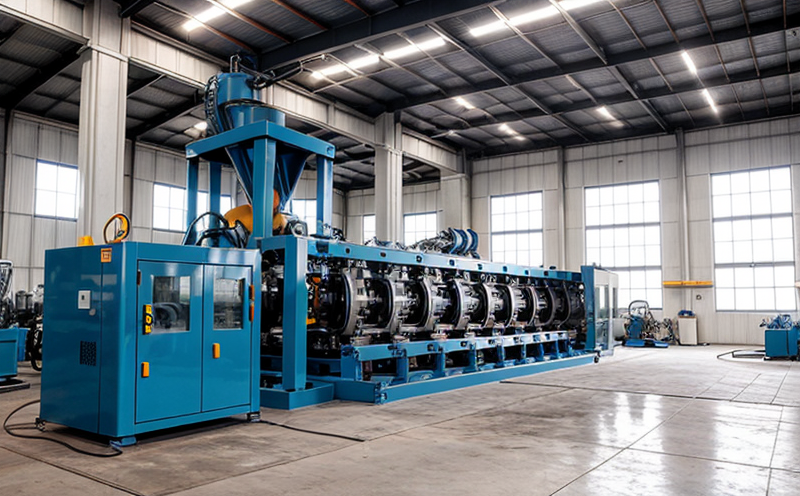ASTM F606 Fastener Performance Testing for Equipment
The ASTM F606 standard is a critical tool used by quality managers and compliance officers in the industrial manufacturing sector to ensure that fasteners are fit for purpose within complex machinery. This testing protocol evaluates the mechanical integrity of fasteners under various stress conditions, providing assurance that they will perform reliably over their intended lifespan.
ASTM F606 is particularly relevant in sectors where machinery and equipment are subject to high loads, such as automotive manufacturing, aerospace, and heavy construction. The standard covers a range of tests designed to simulate real-world stress conditions experienced by fasteners during assembly and operation.
The testing process begins with the preparation of specimens according to ASTM F606 requirements. This includes selecting appropriate materials for the fastener type (e.g., steel, stainless steel) based on expected service environments. Once prepared, the specimen is subjected to a series of tests aimed at assessing its resistance to shear and tensile forces.
Key aspects of ASTM F606 include:
- Shear Testing: Simulates lateral loads that fasteners may experience during assembly or operation. This test helps determine the shear strength of the fastener, ensuring it can withstand lateral forces without failure.
- Tensile Testing: Evaluates the ability of a fastener to resist tensile loads. This is crucial for understanding how well the fastener will hold in tensional stress conditions typical in many industrial applications.
The tests are conducted using specialized equipment designed to replicate realistic operational and environmental stresses. The results provide detailed insights into the mechanical properties of the fasteners, enabling manufacturers and quality assurance teams to make informed decisions about product design and material selection.
ASTM F606 is widely recognized for its robustness in ensuring that fasteners meet stringent performance criteria across diverse industrial sectors. Its application helps prevent costly failures due to substandard components, thereby enhancing overall equipment reliability and safety.
Scope and Methodology
The ASTM F606 standard encompasses a comprehensive range of tests aimed at evaluating the performance of fasteners under various stress conditions. The scope includes both shear and tensile testing, which are critical for ensuring that fasteners can withstand the mechanical demands they encounter in real-world applications.
Shear testing is conducted using fixtures designed to apply lateral loads parallel to the plane of the fastener's head. This test assesses the fastener’s ability to resist lateral forces without failure, which is essential for components subjected to high shear stresses during assembly or operation.
Tensile testing involves applying a controlled tensile load along the axis of the fastener. The objective here is to determine the maximum stress that can be applied before the fastener fails in tension. This test ensures that the fastener will not break under typical operational conditions, enhancing overall equipment reliability.
Both tests are conducted according to strict ASTM F606 guidelines, ensuring consistency and accuracy in results. The methodology involves precise specimen preparation, calibrated testing equipment, and standardized procedures to minimize variability and ensure accurate interpretations of test results.
ASTM F606 also specifies acceptance criteria that must be met for fasteners to pass the tests successfully. These criteria are based on industry standards and practices, ensuring that only high-quality components are approved for use in critical machinery and equipment.
Benefits
- Enhanced Reliability: ASTM F606 testing ensures that fasteners meet the highest performance standards, reducing the risk of failures due to substandard components.
- Compliance Assurance: Compliance with ASTM F606 helps manufacturers and suppliers meet regulatory requirements and industry best practices.
- Economic Efficiency: By identifying potential issues early in the development process, ASTM F606 testing can prevent costly rework and downtime associated with failed fasteners.
- Increased Safety: Ensuring that fasteners meet rigorous performance criteria enhances overall equipment safety, protecting personnel and assets from potential hazards.
These benefits contribute to a more efficient and reliable manufacturing process, ultimately leading to higher quality products and increased customer satisfaction.
International Acceptance and Recognition
The ASTM F606 standard is widely recognized and accepted across various industrial sectors, including automotive, aerospace, construction, and manufacturing. Its acceptance is driven by the stringent quality control measures it imposes on fastener performance.
Many international standards organizations have adopted ASTM F606 as a reference for fastener testing. For instance, ISO 4735:2019 and EN 14382 are aligned with ASTM F606 in terms of scope and methodology, further emphasizing its global significance.
Manufacturers who comply with ASTM F606 standards benefit from enhanced credibility in the international market. Compliance ensures that their products meet the highest quality benchmarks, which is crucial for gaining competitive advantage and securing contracts with major industry players.
The widespread acceptance of ASTM F606 also fosters a culture of continuous improvement within manufacturing processes. By adhering to this standard, companies can ensure that they are at the forefront of technological advancements in fastener performance testing.





